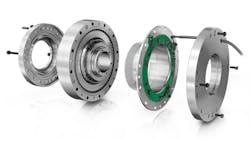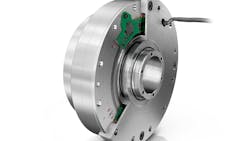Mechatronics Bring Performance Improvements to Range of Applications
Today, it is hard to find applications which do not utilize mechatronics — the combination of mechanical, electric and software technologies — in some manner. Doing so can help to improve throughput, efficiency and operator comfort by enabling more precise control and intelligence to be built into a vehicle or machine.
In this interview with Power & Motion, Craig Hooker, Director of R&D and Mechatronics at Schaeffler in the Americas, provides an overview of what mechatronics systems entail, how they are being utilized, and what is driving widespread use of these systems.
Editor’s Note: Questions and responses have been edited for clarity.
Power & Motion (P&M): Mechatronics is not always a clearcut term that everybody is familiar with or knows much about, so to start our conversation, could you define what mechatronics is or what it means to a company like Schaeffler?
Craig Hooker (CH): To make it simple, mechatronics is a combination of mechanics, electronics and software, usually embedded software. For Schaeffler Group, that means developing products that consist of those different disciplines or components.
P&M: What technologies are associated with a mechatronics system?
CH: The easy way to do it is break it down into those different elements that I just mentioned. If we think of mechanics, then usually the component technology would be things like some type of transmission system — it could be planetary gears, strain wave gears, parallel gears, etc. It could be a screw-driven system like lead screws, roller screws, ball screws; it could be belt drives, rack and pinion, cam drives, etc. Usually there is something that is creating motion of some type, so you have a mechanical transmission system, then bearings that support the rotation of the system, you would have structural housing [including] end plates, shafts, those type of things.
And in addition to that you have electronics like microcontrollers that do the intelligence or control of the device. If it’s a motor related production, typically you would have a power driver as well. Usually, you have some type of sensing, feedback sensing like position and speed, or torque and force, or vibration.
And then also there’s usually software included that’s doing the control or adding the intelligence to those devices.
P&M: How are mechatronics being used within various types of applications? Are there certain applications where you see these systems used most, or which they are most benefitting?
CH: I’d probably generalize and say when I think of mechatronics, it's usually to do some type of sensing on a machine or a vehicle, or to create motion. And so, within those two spaces, there's usually an intent to use that to improve throughput or the efficiency of the machine; I have this machine, and I want to add mechatronics in order to get more throughput or a lower production cost out of my machine.
The other area would be to add comfort or user features. If I want to buy a vehicle and I want to push a button, and I want something to happen, I could pull a lever mechanically, but I'd really like to push the button because it's more convenient for me. Those are typically areas that drive the use [of mechatronics].
And then application areas are everywhere. I mean, it's almost hard not to find mechatronics products, once you've defined it, like I'd mentioned earlier, because there's so many things today that integrate electronics and software into a machine or device. A couple of examples would be the off-road market where you have tractors or scissor lifts; you'll see traditional mechanical components like hydraulics, for example, but you also see a lot of trends to convert that into electromechanical [components] or add intelligence to the hydraulics themselves. Electrification is a big push within that market to add this intelligence and efficiency to machines. Robotics is an area…you can't have robotics without mechatronics because it's a very precise motion control application. And so typically, [you need] to have some type of embedded control and electronics in order to be able to accomplish that. You see lots of examples in robot arms or the humanoid [robot] push that [is happening] in the market today. All of those have lots of mechatronic examples inside of them.
P&M: What role do you see hydraulics and pneumatics playing within the mechatronics space?
CH: When somebody says mechatronics, my first thought is usually towards electromechanical devices. Usually, I have hydraulics or pneumatics and I’m going electromechanical. And that’s certainly an example of mechatronics. But also, I think you can say hydraulics and pneumatics can have mechatronics embedded inside of it. There’s servo control valves, for example, in hydraulics where you’re trying to improve the efficiency of the system, and there you have electronics doing some type of solenoid control and getting feedback in order to control the hydraulic loop. Similar on the pneumatic side, there’s valve control to get better performance out of those systems.
So, I don’t think that they’re mutually exclusive. You can have mechatronics within those spaces but of course there’s also the trend to evaluate those as technologies where you may be improving upon that by going to electromechanical mechatronic type systems.
P&M: How have you seen the use of mechatronics evolve in recent years, and how do you foresee them continuing to evolve in the coming years?
CH: There’s definitely been an evolution, or an advancement, of the technology, more so on the electronics and the software side than the mechanics. A lot of mechanical technology has existed for many years; certainly, there have been improvements on that but where you really see a rapid improvement is more in the electronics and software.
If you look at electronic components that would go into circuit boards, like microcontrollers and integrated circuits, those have become much more available, much less expensive, smaller, more powerful [and] easier to use. So, it really is an enabler then that you can create a lot more products at a lower barrier to entry than you could create previously, and that opens up a lot more business cases and opportunities to put products into the market. I think that curve is continuing to accelerate, and the expectation is that it will accelerate into the future.
Market trends drive that as well. You have robotics, AI (artificial intelligence), automation, electrification, all of these things that we hear about a lot in the news today, those are all areas that need products that require mechatronics. So, there’s the pull from the market side as well.
The last point would be also from the customer side. People are much more familiar with electronics today than they were decades ago. You almost have an expectation among the modern consumer that they want these conveniences they see in their car or have on their iPhone; they want that in their machines and vehicles that they use for other purposes as well. That also creates this pull to have the technology in the market.
P&M: Are there potentially markets or applications where mechatronics is not widely used at the moment but could benefit from utilizing those systems?
CH: I don’t know that there’s an untapped market. Back to my comment earlier, it’s really hard to think of a market that doesn’t use [mechatronics] in some form. If you go back in time, everything was mechanical. And you look at industries like textiles for example, it was all driven by gears and cams and timing of machines. Those types of products were more difficult to make, you had less flexibility.
And so, I think the [mechatronic] technology has already been pretty broadly adapted. The areas where people would typically stick to more of a mechanical system [are those in which] there may be a reason for that based on power density or something else where it forces you into that space. But in general, I don’t see a market where [mechatronics] hasn’t been discovered yet.
Watch "Understanding What Mechatronics is and the Technologies Involved" for the video version of this interview with Craig Hooker.
About the Author
Sara Jensen
Executive Editor, Power & Motion
Sara Jensen is executive editor of Power & Motion, directing expanded coverage into the modern fluid power space, as well as mechatronic and smart technologies. She has over 15 years of publishing experience. Prior to Power & Motion she spent 11 years with a trade publication for engineers of heavy-duty equipment, the last 3 of which were as the editor and brand lead. Over the course of her time in the B2B industry, Sara has gained an extensive knowledge of various heavy-duty equipment industries — including construction, agriculture, mining and on-road trucks —along with the systems and market trends which impact them such as fluid power and electronic motion control technologies.
You can follow Sara and Power & Motion via the following social media handles:
X (formerly Twitter): @TechnlgyEditor and @PowerMotionTech
LinkedIn: @SaraJensen and @Power&Motion
Facebook: @PowerMotionTech

Leaders relevant to this article:



